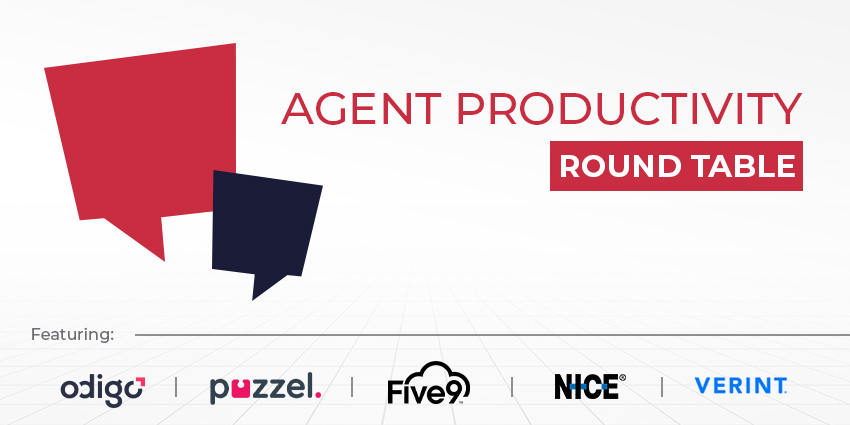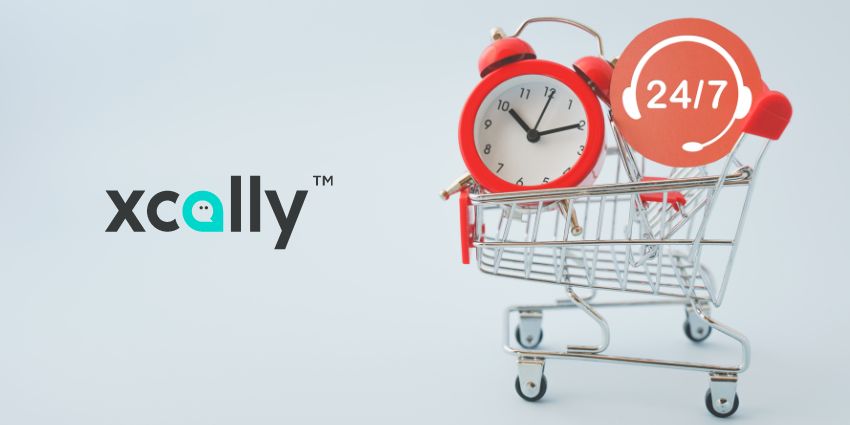Keeping agents engaged in a remote working environment poses a challenge for many businesses. Remote working can easily affect agent productivity and impact the end-customer. With an effective gamification strategy and the right workforce optimisation tools, companies can keep agents connected and empowered ultimately leading to higher levels of motivation and improved customer interactions.
In this edition of the CX Today round table, we welcome:
- Jonathan Allan, Chief Marketing Officer, Puzzel
- David Noone, Strategic Innovation Lead and Key Account Director, Odigo
- Brian Spraetz, Senior Product Marketing Manager, Five9
- Chris Bauserman, VP, NICE CXOne
- Dave Singer, VP Go-To-Market Strategy, Verint
Our panellists will discuss how live agents can keep motivation up while working remotely, what analytics measure agents’ productivity and the benefits of forecasting high call volumes with workforce optimisation tools.
How can businesses keep live agents motivated while working remotely?

Allan: “From gamification to wallboards — there are lots of ways to keep agents engaged and motivated on the job. But for more permanent results, businesses need to take a more holistic approach.
Offering more flexible working hours, providing clearer pathways for career progression and empowering teams with reliable and intuitive tools that make it easier for them to do their jobs successfully, are key to achieving long-term agent engagement and productivity.
At Puzzel, we call it Agent Experience, and have seen firsthand the impact it can have on customer satisfaction, agent retention and revenue. The more empowered your agents feel, the more motivated they’ll be to deliver exceptional experiences for your customers, and the more loyalty they’ll earn for your business.”
Noone: “Agents need to feel connected to their wider teams. There is a highly sociable element to many contact centres that is easily lost when teams are working remotely, so regular and transparent communication is crucial here. Moreover, ensuring teams understand the importance of their roles and identifying the impact they have on the brand and customer experience (CX) is critical. So don’t skip those 1-2-1 meetings and stay alert for signs of burn-out or exhaustion.
Organisations also need to continue to invest in remote working technologies, as this will give their team the best tools for the job, provide adequate training and recognition when they’re successful and lead to a greater understanding of their ambitions, meaning agents can build a better career for themselves.
Gamification, workforce management, flexible scheduling and the often-maligned self-service can really help here. Well-designed and intelligently deployed solutions that successfully cater to customers and improve CX by automating more mundane enquiries, really do have an impact on agent productivity.
Furthermore, self-service bots free up an agent’s time to deliver quality engagements with their customers, reducing overall stress. Therefore, when well-realised, self-service bots are a benefit to all, not a hindrance.”

Spraetz: “An effective gamification strategy, based on measurable rules and metrics that align with a company’s goals, can help businesses motivate and engage their remote contact center agents.
Gamification, an extension of performance management and Workforce Optimization (WFO), incorporates game elements into agents’ day-to-day activities. It helps agents remain focused with a variety of pre-defined games and challenges, including personalized avatars associated with their rewards and achievements.
Gamification can create a sense of healthy competition and interaction among dispersed teams as agents compete to win both virtual and real-life prizes – from recognition to cash. It also allows supervisors to reward continued learning, good performance and positive behavior.
Integrating gamification with agent performance dashboards allows agents to access their daily metrics and easily engage in games and challenges tied to performance goals.”
Bauserman: “Keeping agents engaged is all about preserving the flexibility that working remotely offers, while making sure they feel recognized, connected to their teammates and the company culture and on track to achieve their career goals. That’s a lot of ground to cover, and I’ve found that AI-driven WFM (Workforce Management) tools help set agents up for success in all those areas, whether they work remotely or in a hybrid setup.
Automation frees up agents from more mundane, time-zapping tasks. AI can also fuel real-time feedback and guidance for both specific interactions and an agent’s broader skills development and career growth.
Having clear, instant feedback is a win-win. It helps agents create better customer experiences while helping them to stay proactive and engaged and have greater ownership over their career trajectory.
According to an ICMI study, the number one factor that contributes to agent satisfaction is rewards and recognition. Within a hybrid workforce model, it’s best to have an automated strategy that can reach both at-home and remote workers equally and consistently. Using an integrated gamification platform to create challenges around KPIs is a powerful tool that helps employees meet goals while bonding with their teams.”
Singer: “It’s all about Engagement. The live agents have to feel supported and connected, not like they ‘alone on an island’. This has to be a cultural imperative that is supported by the right tools and technology.
For example, employee communities as a ‘virtual water cooler’ to bring back that connection outside of ‘work questions’. Automated quality solutions feeding live coaching sessions let the agents know that their work is important and that their managers are connected/invested in them. And, mobile collaboration-oriented (e.g. shift swap/request) Workforce Management (WFM) tools let them manage their work/life balance when and where they want to.”
What analytics tools are out there to help measure agent productivity?
Allan: “We partner with market-leading technology providers, such as Indicate me and EvaluAgent, to help our customers measure, track and improve agent productivity. Indicate me provides a 360-degree view of contact centre performance, including average handling time and efficiency, to help managers track productivity and identify areas for improvement. EvaluAgent then specialises in quality assurance, helping businesses close the loop with streamlined agent evaluation processes to solve problems and achieve results faster. Both of these solutions integrate seamlessly with our Contact Centre.”

Noone: “Agent productivity is typically a composite of efficiency, customer effort and interaction demand. These key measures impact productivity more than almost all other KPI’s.
Many tools are available to analyse productivity, ranging from raw statistical analysis through to AI- driven technologies with machine learning ML-based self-tuning capabilities. The latter is able to adjust workflow, interaction models, contextual routing and even staffing models based on the A or ML-based performance analysis of the contact centre’s KPis and forecast data.
Recent research undertaken by Davies Hickman, and commissioned by Odigo, has revealed that 89% of European executives believe that AI-based customer experience (CX) solutions will contribute to future business success. In contrast 81% believe that their organisation’s lack of AI knowledge stops investment in these technologies. Education in this area, aligned with vendor simplification of the technology deployment options, will ensure that these AI-based productivity tools become mainstream.
Finally, these technologies must be deployed while considering the contact centre’s specific function and goals, both now and in the future. Generally, a combination of outside-in (CSAT, NPS, and CES), inside-out (attrition, ESAT, and FCR) and fiscal analysis (ROI, ROCE, and cost), is key to measuring agent productivity.”
Spraetz: “Augmenting traditional quality management (QM) with integrated interaction analytics greatly widens the scope and effectiveness of measuring and managing agent productivity.
The ability of interaction analytics to analyze and score agent performance across 100% of captured customer interactions, both voice and digital, solves traditional QM issues around low sample rates, including the potential for scoring bias due to overweighting of statistical outliers and overlooking critical performance gaps.
That’s not to say that traditional QM no longer delivers business value. Integrated interaction analytics makes a QM program more efficient and effective. It does this by automating and improving the process for finding and assigning interactions for manual evaluation.
Random sampling or selection using limited interaction metadata makes finding good interactions to evaluate time consuming and a matter of chance. Good interactions being those offering high value, actionable insights into agent or business performance.
Adding interaction analytics into the selection and assignment process enables the QM program to operate more strategically and deliver more business value. The ability to precisely target interactions exhibiting issues key to achieving business goals or improving individual agent performance transform the QM program into a strategic business asset.”

Bauserman: “Our CXone Quality Management Analytics is built to better understand and enhance agent productivity. It takes each component of every interaction and applies sophisticated analytics, so you really get a deep, actionable understanding of what was communicated and how to improve. That precise feedback means you can provide fairer, more targeted feedback, which ultimately lets you have fewer, but more targeted conversations with agents. You have the insights to pinpoint desired sentiment, where certain words or phrases are used and many other factors that go into each interaction.
We also have a range of solutions that support agent productivity. NICE Workforce Management, NICE Performance Management, NICE Quality Central, NICE Employee Engagement Manager and NICE Back-Office Proficiency Essentials are just some of those offerings. These solutions provide visibility into agent desktop activities, capture data and generate insights about employee behavior on the desktop. They unlock the potential to generate insights around employee productivity scores, knowledge gaps and identify inefficient processes for both front and back-office employees.
NICE Enlighten AI powers many of these solutions, providing sentiment analysis and insights that enable a better, more intuitive understanding of each interaction and how they fit together.”
Singer: “You need to think about agent productivity in two dimensions: how are they communicating and how are they working. On the communications front, tools like Speech/Text analytics and Automated Quality Management can automatically measure their communication against scripts, standards, and customer expectations.
On the working front, tools like Desktop Analytics can measure how much time they are in production tools (vs non-production or idle) as well as measuring how much work is being completed and if correct processes are being followed. Real-time tracking of intra-day metrics can help manage gig worker schedules and micro-shift workers.
Finally, Experience Management (XM) solutions can be used to measure the impact of this work on the end-customer and tie it back to specific agents and interactions.”
What benefits are there in forecasting high call volumes using workforce optimization tools?
Allan: “A WFM solution is one of the most powerful tools you can have in your contact centre toolkit. If you struggle with over- or understaffing, or finding the right combination of agents to meet your customers’ omnichannel demands, a WFM solution can help you with more accurate forecasting and scheduling. Using historical data captured directly from your contact centre, you can generate high-quality forecasts and rotas that ensure the highest service levels for your customers, the best experience for your agents, and the lowest operational cost for your business.”
Noone: “Correctly forecasting high call volumes ensures that organisations have the right agent, in the right place at the right time to deliver a superior customer experience (CX).
Balancing quality objectives, operational constraints, agent skills, and interaction demand is a complex and ever-changing equation. This is why workforce optimisation is important, as it involves analysing past performance data and accurately forecasting future requirements.
Deploying and taking full advantage of workforce optimisation helps to deliver flexible scheduling in a controlled manner. This offers contact centre agents the choice to work from home or other locations.
This benefits both agents and organisations by allowing agents to achieve a better work-life balance and helps organisations to accurately schedule to demand. Additionally, this helps to significantly expand any organisation’s talent pool as it allows contact centres to add anyone with a reliable broadband connection to them!
Offering flexible work patterns and allowing teams to work from home also helps to reduce attrition by up to 60% delivering real bottom-line impact to clients.
Similar to agent productivity, workforce optimisation is poised to make a step-change in capability, as AI and ML-based technologies improve performance and real-time capabilities.”
Spraetz: “Workforce Optimization (WFO) is a powerful tool for reaching the optimal balance between productivity and service. Centers operating 24×7 or with many agent skills present a good business case for investment. Five9 uses a WFO savings calculator to help these organizations discover the financial benefits.
As an example, let’s compare two 100-seat contact centers—one using WFO, and the other not (this is a hypothetical scenario based on our experience with customers).
The center with WFO uses mathematical computations to create schedules that optimally match available agents to forecasted contact volumes in 10 minutes, with a schedule efficiency of 85% (how closely scheduled staff meets forecasted volumes). The center without WFO must manually fit schedules with the forecast. This takes 90 minutes and only reaches a 62% schedule efficiency.
This is an 89% productivity increase, but the impact of schedule efficiency is even more. Lacking a close match between incoming contact volumes and available agents provided by WFO, contact centers must make a hard decision. If they want to consistently meet service level goals throughout the day they will need to overstaff, which increases labor costs. If they want to minimize overtime and understaff, customers will end up waiting to reach an agent.”
Buaserman: “Organizations are facing not just high call volumes, but also huge spikes in interactions from a variety of digital channels. This adds a level of complexity which traditional tools, like spreadsheets, are just not equipped to handle. That’s where cloud platforms come in, offering the agility and scalability needed for workforce planning and total business management. Cloud-based omnichannel platforms like CXone can help improve planning, scheduling and forecasting. All parts of the workforce can draw on that flexibility to increase accuracy in tracking and analysis with time-series methods, “what-if” scenarios, and other predictive modeling.
This essentially gives you a clearer picture of your business needs and how to make staffing more efficient. Compared to manual scheduling, using AI-driven workforce management solutions helps you achieve business goals faster and maximize CSAT while keeping costs in check. These tools can also generate efficient schedules using the contact center’s specific work-rule parameters and proactively optimize intraday schedules and performance. That all adds up to air-tight scheduling and always ensuring the right workforce is engaged in the right place at the right time.”
Singer: “Benefits can be seen from both Tactical and Strategic forecasting.

- Tactical – There are benefits here to the company, the agent, and the customer. From the company perspective, it’s important to understand when volumes will be spiking (and how high) so that it can inform the plan and they can ensure the right levels of staffing so that calls aren’t dropped and the customers are supported. From the agent perspective, if there is not understanding and planning for volume spikes, they agents will suffer the brunt of the wave. This can lead to higher stress, lower performance, and burnout. From a customer perspective, if an organization is not prepared for high volume periods then they could suffer from long wait times, over-stressed agents and will end up with a less than ideal experience and potentially incorrect support.
- Strategic – The benefit here is being able to react to events based on industry, seasonal or other changes. Events like a new product launch, timed offering, government mandate or other activity could drive spikes in volume. This information will help inform staffing and hiring plans
Additionally, it is important to forecast why the volumes will be high. This allows organizations to prepare their Knowledge systems with the right information and prepare their IVA and Self-Service systems to handle and deflect the right kind of calls from the live agents.”







